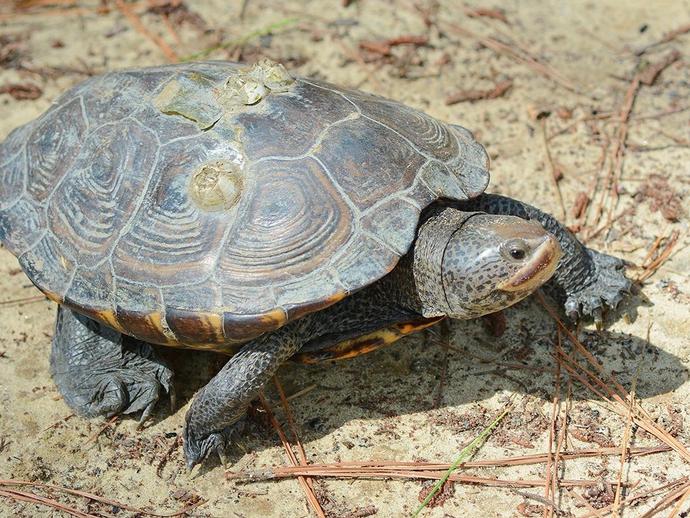February 5, 2021
Ben here with the Friday edition of #BenInNature presented by our friends at Carter Bank & Trust!
We're closing out Herp Month (for real this time!) with our number one pick for Virginia's rarest turtle: Malaclemys terrapin terrapin, the eastern diamond-backed terrapin!
You might wonder what makes a turtle a terrapin (beyond an affinity for the Grateful Dead). The name is derived from the Algonquian word "torope," and was used by early European settlers to describe turtles that live in brackish waters. That ability is what makes this critter so unique; while most aquatic turtles either live in freshwater or saltwater, the diamond-backed terrapin splits the difference! While they're normally found in brackish water, they have been found swimming in the Atlantic Ocean! Unlike sea turtles, they don't possess flippers, but they do have highly webbed hind feet.
There are seven subspecies of these terrapins that stretch along the coasts of the U.S. from New England all the way down to Florida and west to Texas. They can also be found in Bermuda and arrived there naturally rather than being introduced!
If you want to find a northern diamond-backed terrapin in Virginia, they have been recorded in multiple localities surrounding the Chesapeake Bay, and they're probably most common on Virginia's Eastern Shore. Unfortunately, they're not always easy to find because this species has been under threat for quite awhile.
The problem the northern diamond-backed terrapin faces is simple: it's apparently very tasty. These terrapins were extensively harvested for food in the late 1800s/early 1900s, and many of their populations were all but eradicated. The market for these terrapins largely died out in the 1930s, but unfortunately, demand has increased in recent years and the terrapins are being harvested at an unknown rate. To make matters worse, they frequently become trapped in crab pots and drown.
This species is considered Near Threatened on the International Union for Conservation of Nature Red List, and much work needs to be done to determine how large the remaining populations are and what can be done to protect them. My recommendation: maybe people could just stop eating awesome turtles. I've made it 36 years without eating a threatened species and I don't exactly feel like I've missed out.
Thank you to the Virginia Herpetological Society (www.virginiaherpetologicalsociety.com) for the use of this photo.
ABOUT #BenInNature
Social distancing can be difficult, but it presents a great opportunity to become reacquainted with nature. In this series of posts, Administrator of Science Ben Williams ventures outdoors to record a snapshot of the unique sights that can be found in the natural world. New updates are posted Monday - Friday, with previous posts highlighted on the weekends. This series of posts is made possible thanks to the support of VMNH Corporate Partner Carter Bank & Trust (www.cbtcares.com).
NATURE PHOTO IDENTIFICATIONS
If you discover something in nature that you would like help identifying, be sure to message us right here on Facebook with a picture (please include location and date of picture) and we'll have our experts help you identify it!

 Hours & Admissions
Hours & Admissions Directions
Directions

